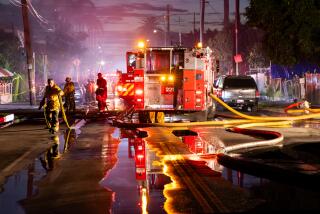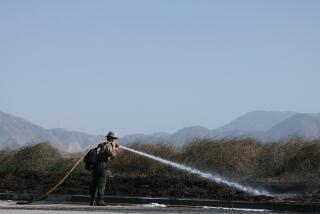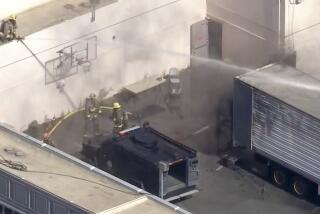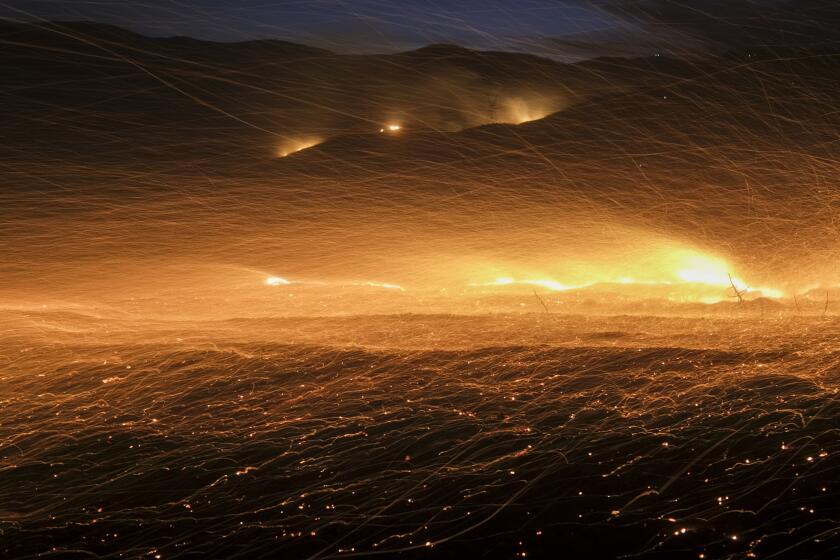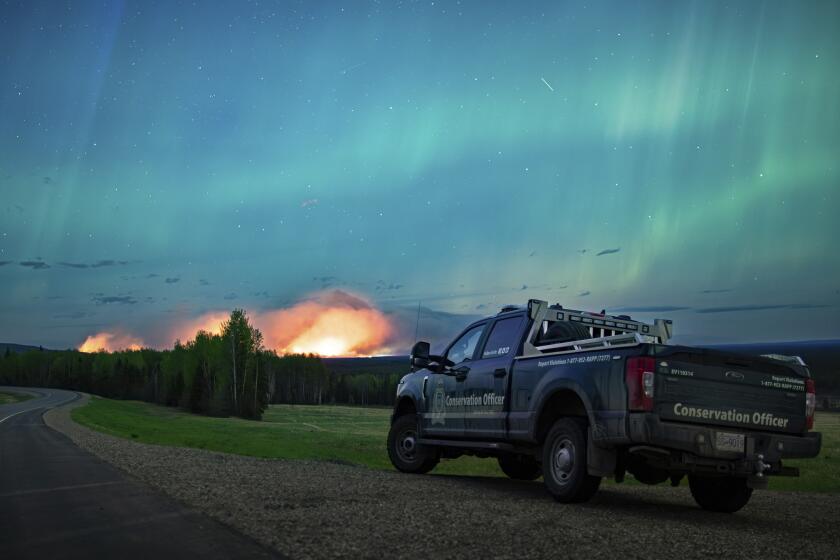‘It’s Pure Adrenaline’ on the Fire Lines
The ground forces are ash-streaked demons, pushing through the brush and smoke, risking their lives to cut off moving curtains of flame. The air crews swoop down from the heavens, navigating power lines and steep canyon walls to dump tons of foam and fire retardant.
Together, they represent the two disparate faces of modern firefighting: old-style, mud-in-the-eye commandos, slogging into the very gates of hell, and jet-age pilots who wage war with the push of a button.
What they have in common is the singular rush that comes from staring down fear and disaster, the way Manuel Castaneda did in the wee hours Tuesday morning as a 13,000-acre blaze roared through Malibu.
“It probably doesn’t get any better for a strike team--flames 20 feet in the air, winds 50 miles an hour blowing embers in your face, and protecting million-dollar homes,” Castaneda, a Los Angeles city firefighter, said during a few minutes’ rest before his small strike team was sent out again. “It’s pure adrenaline.”
Scout pilot Vance Colvig, a Los Angeles County Fire Department member whose helicopter helped to search for six injured ground fighters Tuesday in a flaming canyon, said there are times, even in the air, when a major fire fills his entire field of view--surreal and beautiful--even while the heat becomes intense enough to blister the paint on the aircraft.
“All you can see past the smoke is the dark walls of the canyon with a rim of the fire around it,” Colvig said. “It’s a view that is sometimes very awe-inspiring, the scale and the color. You don’t get to see this too often. . . .”
In urban coastal areas, where pricey homes are tucked high in brushy canyons, ground crews and air units perform an elaborate dance to try to outflank advancing flames and anticipate the shifting of capricious winds. There is danger every moment, as firefighters were brutally reminded Tuesday. Six members of ground crews fighting the Calabasas-Malibu fire were injured when a sudden gust of wind blew a wall of flames directly over them.
For the most part, the ground forces do the dirty work--clearing brush, dragging hoses through blinding smoke, ever-wary of the chance that flames might encircle them.
Ramon Willis, 30, a Los Angeles city firefighter who lives in Canyon Country, usually gets his thrills by off-road racing. But that doesn’t compare to the thrill he got Monday and Tuesday, working around the clock, catching a few minutes’ nap in the wee hours sleeping on his rig in damp fire clothes.
“A hundred miles an hour across the desert in [a] . . . race truck doesn’t even come close to this,” he said. “Fire, smoke, ash--my eyes were burning all night. We were right there.”
For a while, his four-member crew joined other engines in a strike team protecting houses in Malibu Canyon. Flames tumbled down the hillside to within 30 feet of some homes. Willis fought the smoke and darkness, wielding his high-pressure hose while anxious residents brought out sandwiches, even spaghetti.
All the homes at that location were saved. Willis described it all as “fun.”
It is fun, maybe, but high-pressure fun, the type of fun that’s not for everybody.
With chapped lips and a face still blackened by smoke and ash on Tuesday afternoon, Escondido firefighter Bill Atkins remembered a night like no other battling an inferno that roared through northern San Diego County. It left the terrain nothing more than a blackened, scarred moonscape.
“We kept being overrun by it,” Atkins, 39, said. “We kept having to make decisions like, ‘Is this place worth saving? Is there any way we can save it? Or is it too far gone to bother with?’ To show you how bad it was, we thought we had saved one place, and then 30 minutes later, we’d come back, and it was completely engulfed in flames.
“There was tons of heavy fuel, and we fought it all night long. None of us has had a wink of sleep, and we’re told we may be on duty till Friday. It’s that bad.”
By contrast, the air crews have it almost easy. Almost.
While their counterparts scramble with hoses over rutted terrain, helicopter and airplane pilots dump payloads of water, foam and fire retardant with the push of a thumb. But there are power lines to worry about, sightless moments in the smoke with the canyon walls out there somewhere, and other craft buzzing nearby. . . .
To veteran chopper pilot John Finnerty, 48, who was coordinating Tuesday’s helicopter assault on the Calabasas-Malibu fire, it smacks a little of Vietnam, where he flew combat missions for the Army’s 11th Armored Cavalry Division.
“It’s just there’s no bullets here,” the understated, bespectacled pilot said. He uses the term, “pushing chaos” to describe how pilots skirt the edges of disaster during major firestorms.
For the air crews above Malibu, the dramatic moment on Tuesday came about noon, as they raced to lay a wet fire break along mountain ridge tops before an expected shift in wind direction. Finnerty’s Bell 205 helicopter, a standard weapon in the county’s firefighting arsenal, was dumping 350-gallon payloads, 10 an hour, to try to make sure the fire would not change direction and cross the ridge to homes on the other side.
But the wind shifted too soon, and a new flare-up occurred.
“If the wind had waited another 30 minutes, we probably would have had it,” Finnerty said, expressing anguish over the flare-up. “The heat was intense. From a mile away, you could feel the heat.”
Mike Lacy, who has spent a decade as a chopper pilot, has fought forest fires in the Pacific Northwest and flown gunships for the U.S. Army. But conditions this week over the Santa Monica Mountains are the worst he has ever experienced.
He was flying an “air crane” chopper capable of dumping 10 tons of water at a time. But the buffeting winds made it seem his whole craft had been thrown into a washing machine.
“Here I am in something that weighs 42,000 pounds and it’s being tossed around like a rag doll,” the 39-year-old Lacy said.
Smoke is everywhere. But Lacy doesn’t fly through the thickest clouds: There’s not enough oxygen in those super-heated columns of brush-fire smoke to keep the helicopter’s jet engines running. “Your lungs hurt after a week or so,” he said.
While pilots may get a rush out of such hazards, ground support crews endure only backbreaking, mind-numbing manual labor.
“It’s just damn hard work,” said weary Los Angeles County firefighter Fred Chavez, who had spent seven hours toiling at a reloading site for the water-dropping helicopters.
Chavez’s clothes were muddy, his face streaked with dirt and ash. He and his partner, Tim Ruddell, had set up shop in a Malibu cul-de-sac, using a fire hydrant to pump 360 gallons of water at a time into each of a seemingly endless procession of choppers. All the while, the fire swirled around them.
It’s a dangerous job, without a lot of glamour, Ruddell admitted.
“You come back from a day like this, and you’re just beat,” he said. “You know you’ve done your job, and that feels good. But you’re mostly just tired.”
More to Read
Start your day right
Sign up for Essential California for news, features and recommendations from the L.A. Times and beyond in your inbox six days a week.
You may occasionally receive promotional content from the Los Angeles Times.
